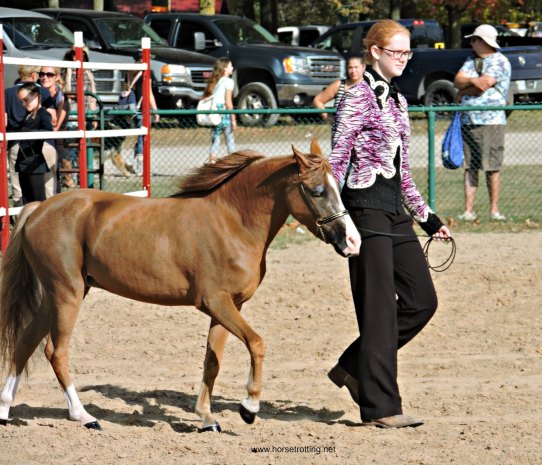 “Are you looking for the miniature horse show too?” A grandmother grasping a young kid in each hand frantically addresses me at the Ancaster Fall Fair last September.
“Are you looking for the miniature horse show too?” A grandmother grasping a young kid in each hand frantically addresses me at the Ancaster Fall Fair last September.
“There’s one there,” the grandfather calls (without any kid in tow) from further away.
And they scampered off in that direction … before I could answer. The Miniature Horse Show judging competition didn’t start for another fifteen minutes, and will likely start late.
Few Fall Fair horse events are more popular than watching small equine, some no bigger than large dogs, led into a ring to be shown like, well, pedigreed dogs.
So, how are these pint-sized ponies judged?
According to the American Miniature Horse Association (AMHA), a miniature horse cannot exceed 34 inches in height measured from the last hairs of the mane. Any bigger then they aren’t official miniatures.
And that’s just the start. While judging seems a bit arbitrary to the spectator – like the household pet category at a cat show – it isn’t. Actual judging criteria listed by the AMHA concerning size, head, temperament, neck, shoulders, ears and even bite, is surprisingly complicated.
 What are the judges looking for while kids and adults walk their minis into the ring then stand, for what seems like days, waiting for the announcer call their numbers?
What are the judges looking for while kids and adults walk their minis into the ring then stand, for what seems like days, waiting for the announcer call their numbers?
Colour: This one’s easy. According to the AMHA, any pattern, markings or eye colour are fine.
Head: Triangular and comparatively small in proportion to the neck with a broad forehead and prominent eyes, but the muzzle should be small with large nostrils.
Bite: Yes, the judge should check the teeth too. Centre incisors should be meet and be even, with some allowance made for age.
Ears: Believe it or not, according to rules ears must be on top the head. But they should have pointed tips curving slightly inward.
Legs: Apparently, there’s a reason some people reposition the horses legs as they stand during judging because on these little guys legs should be “longer than the body is deep.” Legs should be parallel when viewed from the front (hence the adjustment) and the front and back hooves should point directly forward.
Neck: This part is exceptionally complex, but the gist is the length should be proportionate with the body and appear to sit on the withers rather than in front of them.
And these are only the highlights. Judging criteria is detailed (www.amha.org) and takes some memorization to do quickly.
Or not so quickly. Some miniatures stand for a while in the ring, after taking a quick solo run for the judge – which is great for the spectator. This is the time to take some good photos, stand along the fenced perimeter and get a good look at these little cuties. Because they only thing cuter than an extremely cute animal is a smaller version of that animal.
Love Fall Fairs too? Check out our first in a series of Fall Fair Competitions Demystified Part I: The Heavy Horse Hitch
What to learn more about Miniature Horses?
Check out The Book of Miniature Horses on Amazon.com (US) or Miniature Horse: The Complete Guide on Amazon.ca (Canada) (affiliate links)











[…] Simcoe and the Rockton World’s Fair near Hamilton. (Both horsetrotting have covered – check out Rockton and […]
LikeLike